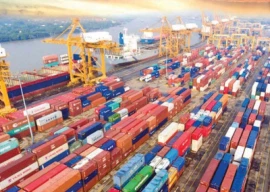1666955840-0/download-(1)1666955840-0.jpg)
Pakistan is fast becoming a food-insecure state due to a widening gap between the demand for wheat and other food crops and their domestic supplies but it will be wrong to put the entire blame on climate change.
Production of sufficient staple crops primarily provides food security. Wheat is the main staple crop in Pakistan. Many other countries have rice as their staple food and ensure adequate supplies through imports.
Calamities like the Covid-19 pandemic, climate-induced floods and droughts and man-made crisis like Russia-Ukraine conflict have triggered a spike in food commodity prices globally and badly impacted countries like Pakistan as they increasingly rely on imported grains. “We still measure food security through the availability of wheat crop. However, the developed world now measures it through the nutrition content in food like zinc and calcium,” said Sindh Abadgar Board Vice President Syed Mahmood Nawaz Shah while talking to The Express Tribune.
Pakistan had produced a huge surplus of wheat in planting season 2018-19 and also exported the harvest. However, it has become a net importer of the grain and several other food commodities in the past few years.
The collapse of Sudan and Somalia, who are dubbed “failed states”, is attributed mainly to food insecurity.
Pakistan has harvested a wheat crop of 26.4 million tons compared to the estimated consumption of around 29.5 million tons in the outgoing year. The deficit is being bridged through expensive imports, though the country’s foreign currency reserves are rapidly depleting. Further imports may be difficult, which puts a question mark over the country’s food security.
A much-needed improvement in cotton production through policy focus, however, can provide some cushion to the dwindling foreign currency reserves. Cotton, along with textile products made from cotton, fetches billions of dollars in exports, constituting 60% of total exports of the country.
“Pakistan’s wheat requirement is expected to reach 33 million tons by 2030. The projection has been made while considering factors like growth in the population size,” Shah said.
The new crop of wheat will start arriving in markets sometime in March-April 2023. Apart from wheat, frequent shortages of essential vegetables like onion, tomato and potato (as well as pulses) have struck Pakistan almost every year over the past several years.
Many experts cite climate change (droughts, heavy rainfall, floods, high temperature and extreme heat and cold) as a leading factor for the drop in per-acre crop yields in recent times. This year, floods have wiped out standing crops over large swathes in the country.
However, other experts believe that poor planning is the major cause of the widening gap between demand and supply of food commodities in the country.
“Policymakers are making no projections of grain demand with almost no planning to address the challenges in the agricultural sector,” Shah said. “Climate change is one big factor behind the rising food insecurity, but not the only factor,” said Sindh Agriculture University Tando Jam’s former lecturer Sono Khangharani.
“A shift in focus from agricultural policy has resulted in the poor state of farming,” he elaborated.
According to Khangharani, high inflation has also emerged as a bigger challenge than climate change that threatens food security.
“Our policymakers, agricultural scientists, environmentalists, social scientists, economic managers and civil society all should equally share the blame for the widening gap between farm output and consumer demand,” he said. This year, farmers have planted the wheat crop late because of floods. Similarly, they have delayed the cultivation of tomato, onion and chilli seeds.
“Growers have adjusted timings of crop sowing in the wake of climate change,” he said. Neighbouring India, which faces almost the same climatic conditions as Pakistan encounters, has continued to produce surplus wheat and is exporting the commodity despite being a big consumer of the grain itself.
The State Bank of Pakistan (SBP) said last week that ensuring food security was primarily linked to wheat supplies. “Policymakers have traditionally relied on price intervention and input subsidies to ensure Pakistan is food secure,” it said. However, the challenges to food security will intensify under climate change from floods, “low productivity, poor infrastructure, among other factors”.
It cited several policy options that could be considered to counter the threat of climate change. “There is a need to increase policy focus on introducing high-yielding varieties of wheat through research and development among others.”
Shah pointed out that Sindh had continued to use the outdated TD1 wheat seeds while Punjab recently de-notified it following the rust disease.
“There is a dire need to focus on planning, and research and development to improve food security,” he said. “We should decide now to plan for the next 10 to 20 years through policymaking. The change will not come tomorrow.”
Pakistan had achieved food security by becoming self-sufficient for the first time in 1970 – almost 23 years after independence in 1947. It was the outcome of three consecutive five-year plans from 1956 to 1970.
The writer is a staff correspondent
Published in The Express Tribune, December 26th, 2022.
Like Business on Facebook, follow @TribuneBiz on Twitter to stay informed and join in the conversation.


1725612926-0/Tribune-Pic-(8)1725612926-0-165x106.webp)


















COMMENTS
Comments are moderated and generally will be posted if they are on-topic and not abusive.
For more information, please see our Comments FAQ